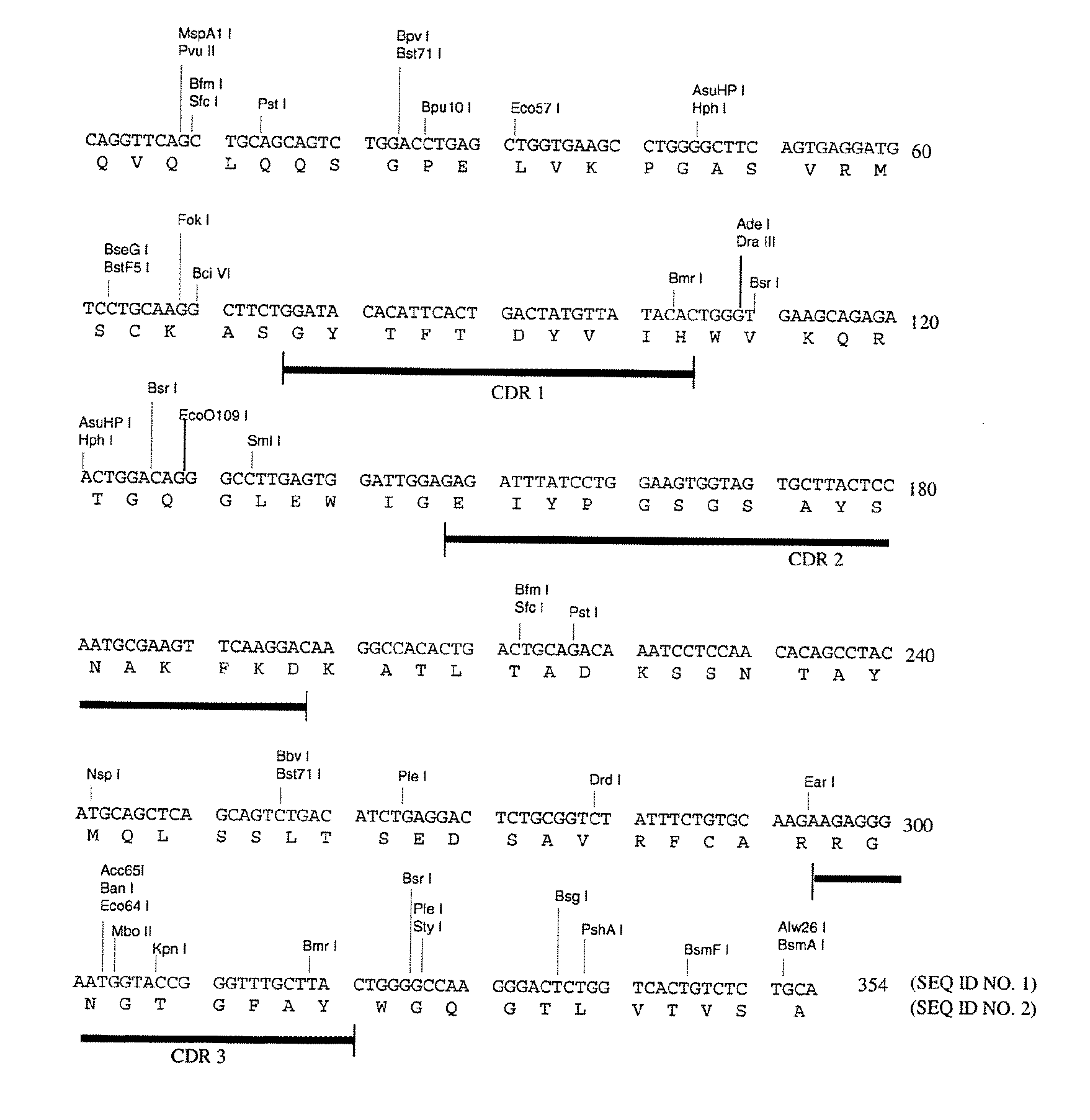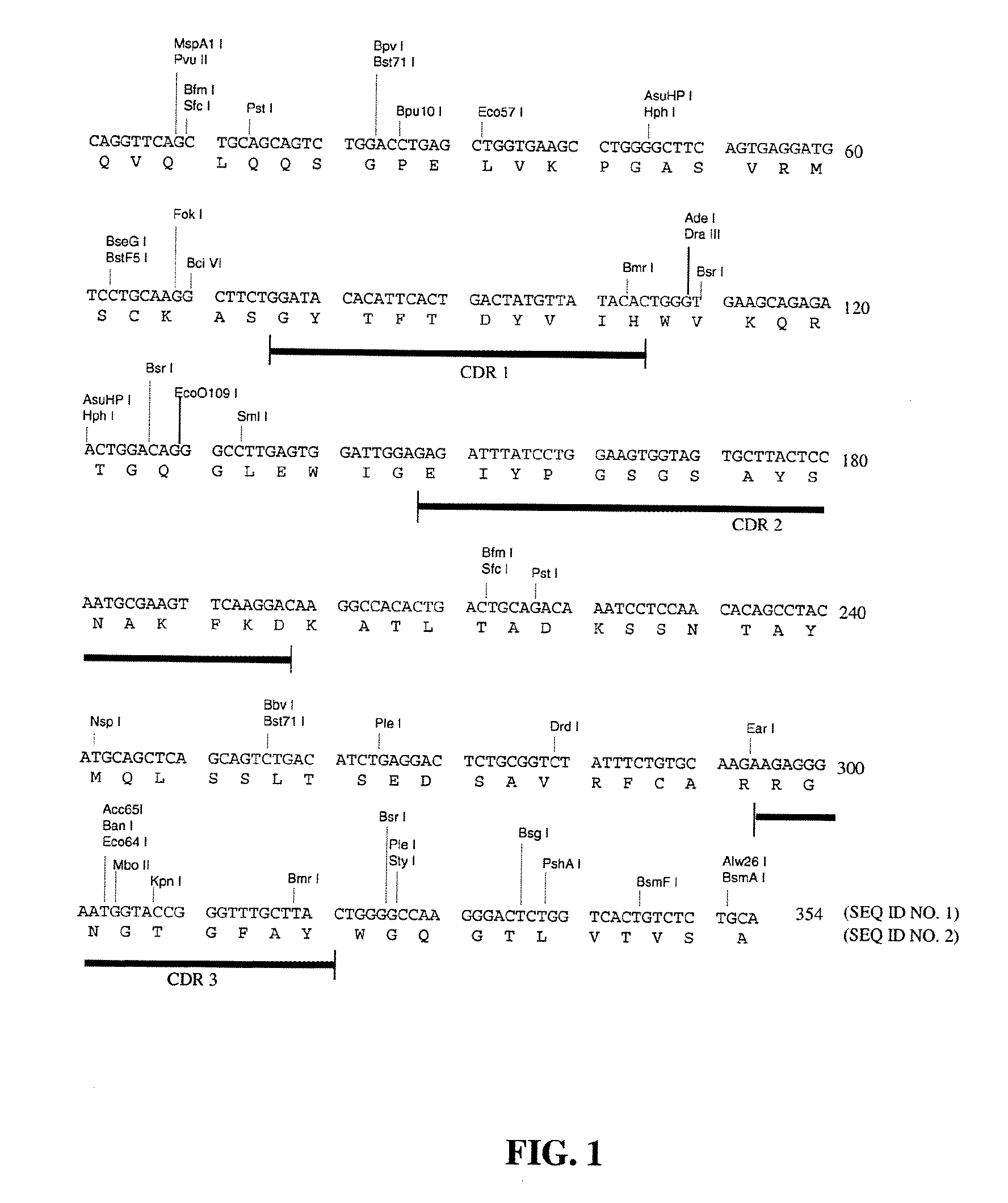Deimmunized monoclonal antibodies for protection against HIV exposure and treatment of HIV infection
a technology of immunomodulatory antibodies and monoclonal antibodies, which is applied in the field of immunomodulatory monoclonal antibodies for protection against hiv exposure and treatment of hiv infection, can solve the problems of lack of understanding of the immune response necessary for inhibition of hiv, major obstacles to hiv immunotherapy development, and optimism was soon shaken, so as to reduce the cost, prevent the effect of hiv exposure, and large-scale production
- Summary
- Abstract
- Description
- Claims
- Application Information
AI Technical Summary
Benefits of technology
Problems solved by technology
Method used
Image
Examples
example 1
Cloning and Characterization of the Murine mAb B4 Genes
1. Preparation of Total RNA
[0138]Total RNA was extracted from 5×106 hybridoma B4 cells by using the Promega (Madison, Wis.) SV40 Total RNA Isolation System (Cat. No. Z3100) according to the manufacturer's instructions.
2. Amplification of cDNAs Coding for Mouse Heavy Chain Variable Region (VH) and Light Chain Variable Region (Vκ)
[0139]Synthesis of the single stranded cDNA and amplification of cDNAs coding VH and Vκ were done using GeneAmp® RNA PCR Kit (Perkin Elmer, Norwalk, Conn., part no. N808-0017), according to the manufacturer's instructions.
[0140]Briefly, the single stranded cDNAs coding for mouse heavy chain and light chain were synthesized from 1 μg of the total RNA by using MuLVu Reverse Transcriptase using oligo(dT)16 as primer. The reaction mixture was incubated at 42° C. for 15 minutes, at 99° C. for 5 minutes, and then at 5° C. for 5 minutes.
[0141]The single stranded cDNAs of VH and Vκ were amplified by AmpliTaq DNA ...
example 2
Construction of Chimeric B4 Antibody Genes and their Expression by NS0 Cells
1. Construction of Chimeric Antibody Genes
[0143]The chimeric B4 antibody consists of mouse-human antibody chains made by taking the variable region genes for murine mAb B4 and joining them to the human immunoglobulin constant region genes, in a manner similar to that described by Morrison et al. [19]. In this fashion, the fully murine variable regions were linked to human constant regions. The chimeric antibody provides a useful undeimmunized control with the same human constant regions, for comparisons when testing the B4-derived antibodies having deimmunized variable regions.
[0144]For the construction of the chimeric B4, the vectors VH-PCR1 and VK-PCR1 [20] were used as templates to introduce the 5′ flanking sequence including the leader signal peptide, leader intron and the murine immunoglobulin promoter, and the 3′ flanking sequence including the splice site and intron sequences, around the murine VH and...
example 3
Design and Construction of Deimmunized Variable Region Sequences
6. Design of Deimmunized V Sequences
[0153]The amino acid sequences of mouse B4 VH and Vκ were compared to the sequences of the directory of human germline VH [33] and Vκ [34] sequences and also to human germline J region sequences [49]. The human germline VH, J region and Vκ sequences with the highest homologies to the murine B4 VH and Vκ were chosen to be the reference human framework sequences.
[0154]Following identification of the reference human framework sequences, certain non-identical amino acid residues within the B4 VH and Vκ frameworks which are surface exposed were changed to the corresponding amino acid in the human reference sequence [24]. Residues which were considered to be critical for antibody structure and binding were excluded from this process and were not altered. For example, the murine residues at the N-terminus, which are close to the CDRs in the final antibody, were retained. This process produce...
PUM
| Property | Measurement | Unit |
|---|---|---|
| concentration | aaaaa | aaaaa |
| temperature | aaaaa | aaaaa |
| temperature | aaaaa | aaaaa |
Abstract
Description
Claims
Application Information
 Login to View More
Login to View More - R&D
- Intellectual Property
- Life Sciences
- Materials
- Tech Scout
- Unparalleled Data Quality
- Higher Quality Content
- 60% Fewer Hallucinations
Browse by: Latest US Patents, China's latest patents, Technical Efficacy Thesaurus, Application Domain, Technology Topic, Popular Technical Reports.
© 2025 PatSnap. All rights reserved.Legal|Privacy policy|Modern Slavery Act Transparency Statement|Sitemap|About US| Contact US: help@patsnap.com



